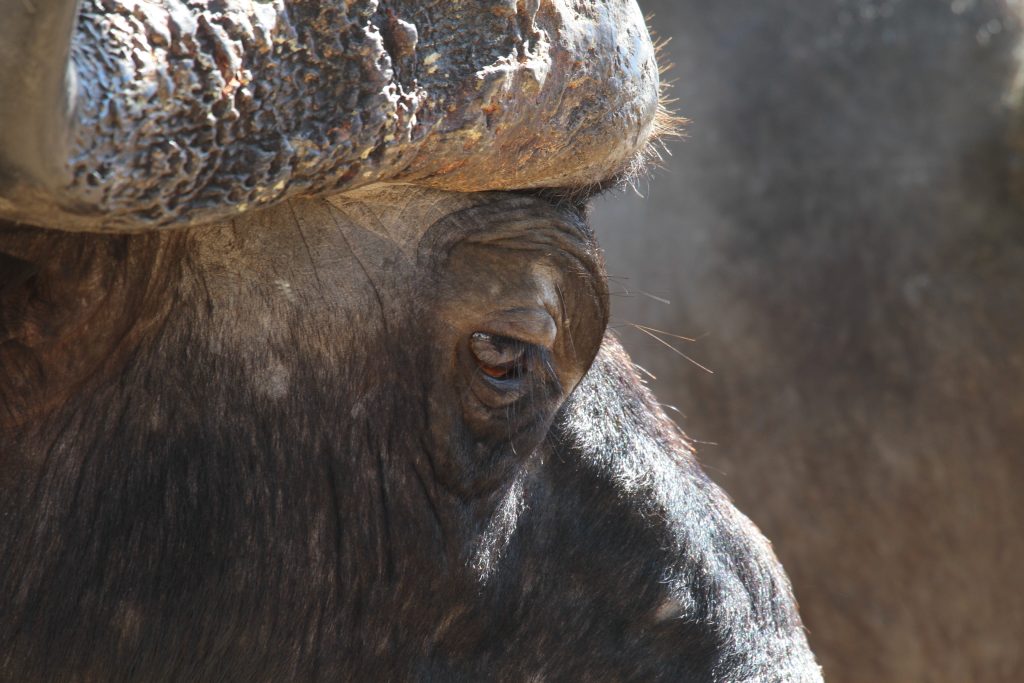I hope it does not happen to you. If it does you have got a bucketful of trouble. The first shot is the critical one. If you see the buffalo wheel away and you know deep down that you have duffed the shot then be assured that particular day will probably turn out to be one of those memorable days in your life that will stand out head and shoulders above the rest and, hopefully, you will live to tell the tale.
No one, unless they have a death or severe injury wish, will wound a buffalo on purpose. It is just not a sane thing to do. But life happens and buffalo sometimes are unintentionally wounded during a hunt and this can lead to all types of not so fun and games. Daunting? Yes! Exciting? Most definitely! But not the sort of thing you would want to do too often.
Most hunters will go for a heart/lung shot in buffalo and in most cases from a side-on presentation. See Figure 1.
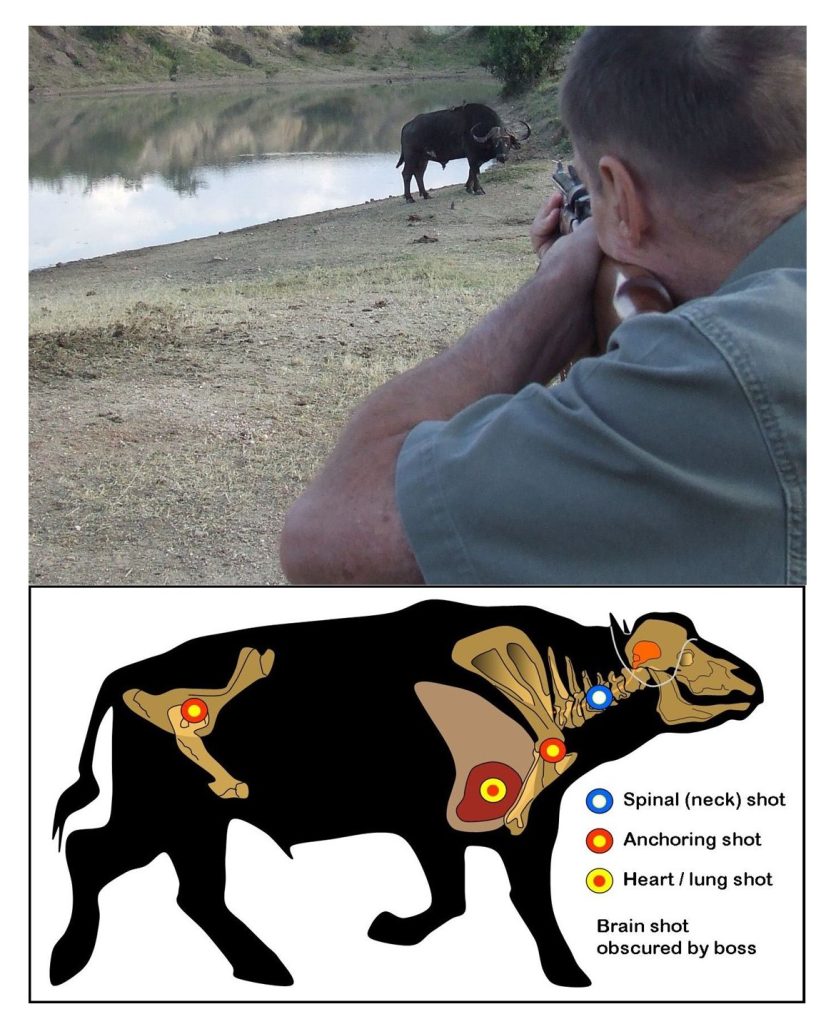 It should come as no surprise if the animal runs off after being hit in this vital area. In the strictest sense, it has not been wounded. It has received a mortal shot and is in the process of dying – the dying may take seconds to four or five minutes and the beast may cover some ground before blood loss and falling blood pressure cause it to lose consciousness, collapse, and die from no oxygen reaching the brain. But things can go wrong – an unseen twig may deflect the bullet or arrow, the animal may move forward at the precise moment that the sear disengages and the shot goes off or it may just be one of those times when you have fired a poor shot. Whatever the reason if a vital area is not hit and the animal is not going to die within five or six minutes after the shot then we can regard it as wounded and a follow-up will be needed to complete the job.
It should come as no surprise if the animal runs off after being hit in this vital area. In the strictest sense, it has not been wounded. It has received a mortal shot and is in the process of dying – the dying may take seconds to four or five minutes and the beast may cover some ground before blood loss and falling blood pressure cause it to lose consciousness, collapse, and die from no oxygen reaching the brain. But things can go wrong – an unseen twig may deflect the bullet or arrow, the animal may move forward at the precise moment that the sear disengages and the shot goes off or it may just be one of those times when you have fired a poor shot. Whatever the reason if a vital area is not hit and the animal is not going to die within five or six minutes after the shot then we can regard it as wounded and a follow-up will be needed to complete the job.
When hunting, and especially in the case of dangerous game, make absolutely sure of the first shot. If, for whatever reason, the animal does not drop immediately and turns to run off after having been hit, assume that it was a bad shot (it might be good, but don’t take this as a given), and try and get a second shot in before it disappears from sight. If the animal presents itself in such a way that a second heart/lung shot is possible or a brain shot presents itself, go for one of these two options. An animal headed away from you does not often present one of these two options, however, and you may have to consider an anchoring shot, which is one fired into that part of an animal that will cause structural failure at some point in the skeleton, making it impossible for the animal to continue running, cause it to fall, and hopefully buy you enough time to get into position to deliver a final and lethal shot and so bring the hunt to its conclusion. Anchoring shots can be aimed to break the shoulder, hip, or lower spine. In buffalo headed away from you, the shot can be aimed at either the hip joint or the base of the spine. See Figure 2. If you are dextrous enough to cycle a second round through the action of a bolt action rifle in time or have the luxury of a double enabling you to get an anchoring shot in before the buffalo heads off into the blue yonder, then the job may be over – well almost……. If the buffalo goes down, circle around to its head side and despatch it with a brain shot. Figures 3 and 4 illustrate the position of the brain as seen from the front and side on.
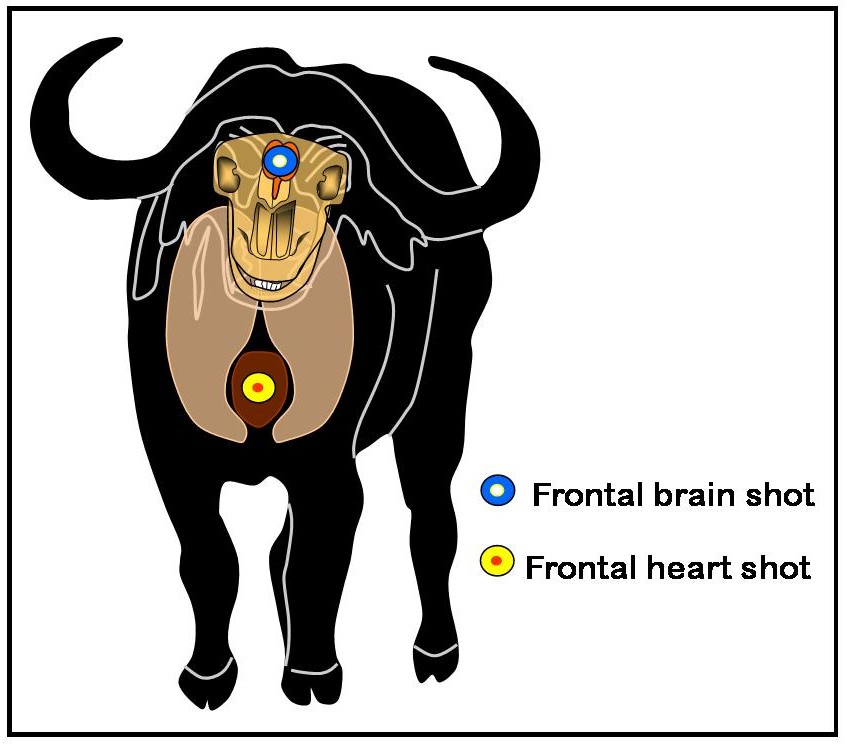
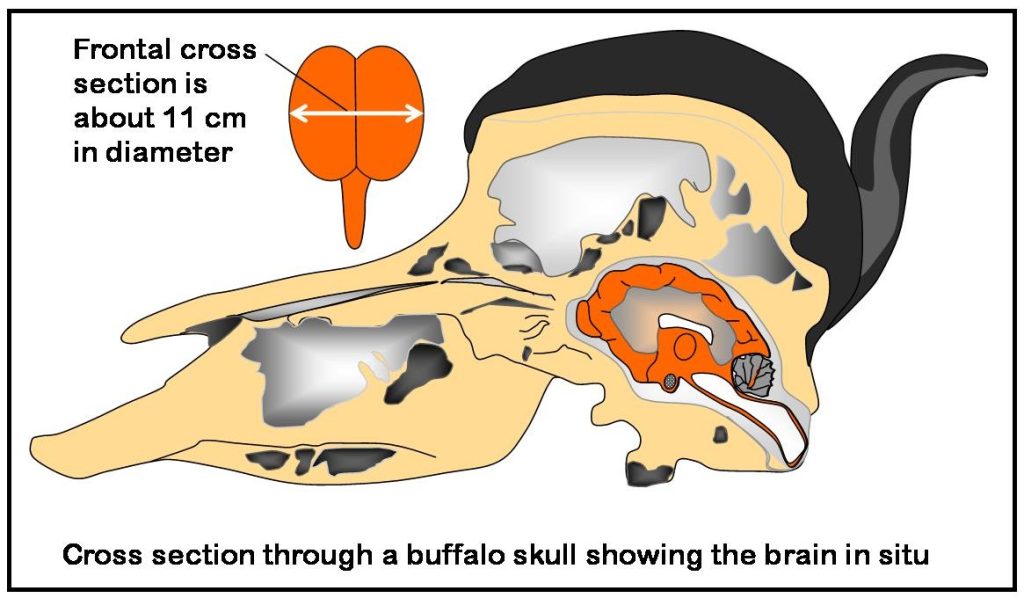
But take care down is not necessarily out! Even with the hip joint or lower spine smashed by a bullet rendering the hindquarters paralysed or inoperable a buffalo may still attempt to pull itself forward by its front legs so stand at least five or ten meters away when giving the brain shot. See Figure 5.
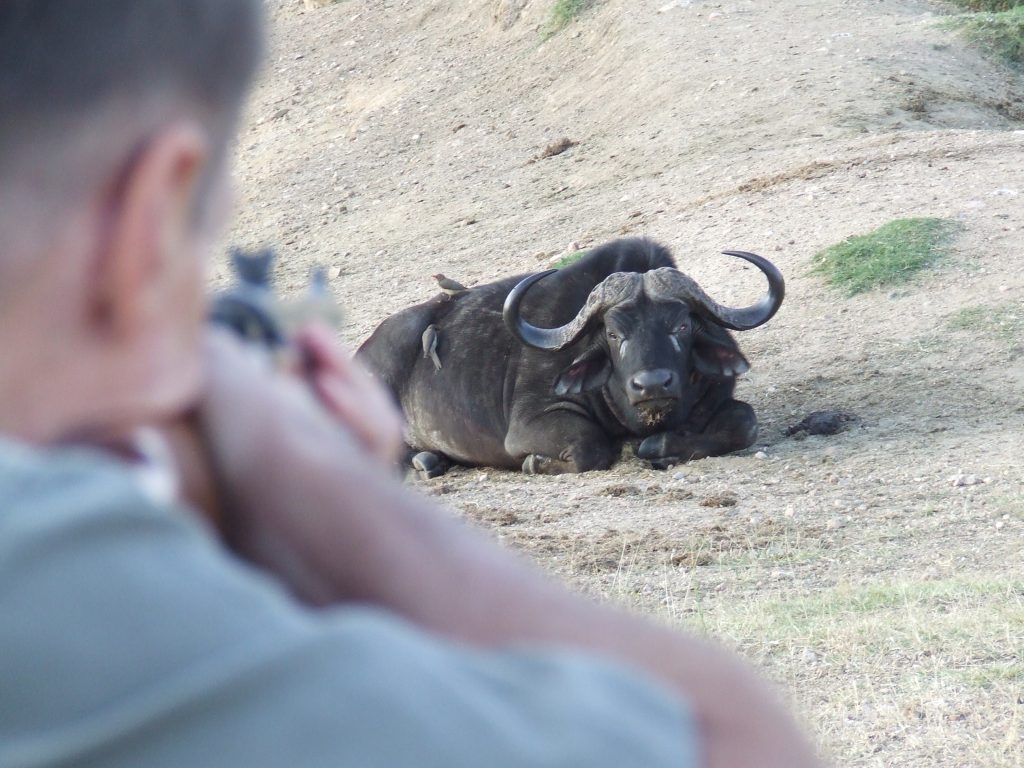
When going for a brain shot use a monolithic solid as there is a substantial amount of bone tissue to punch through to reach the brain (Figure 6).
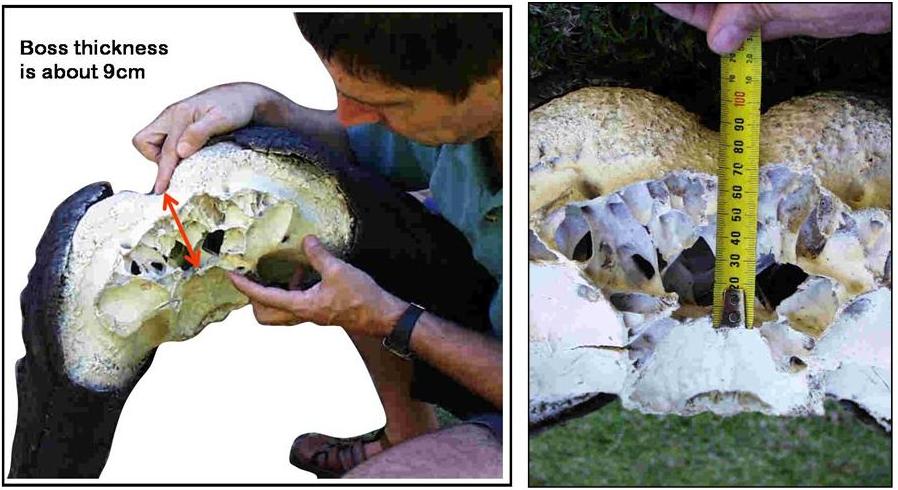
When placing headshots, the orientation of the buffalo’s head relative to the hunter must be taken into consideration as this will determine your aiming point to hit the brain (Figure 7).
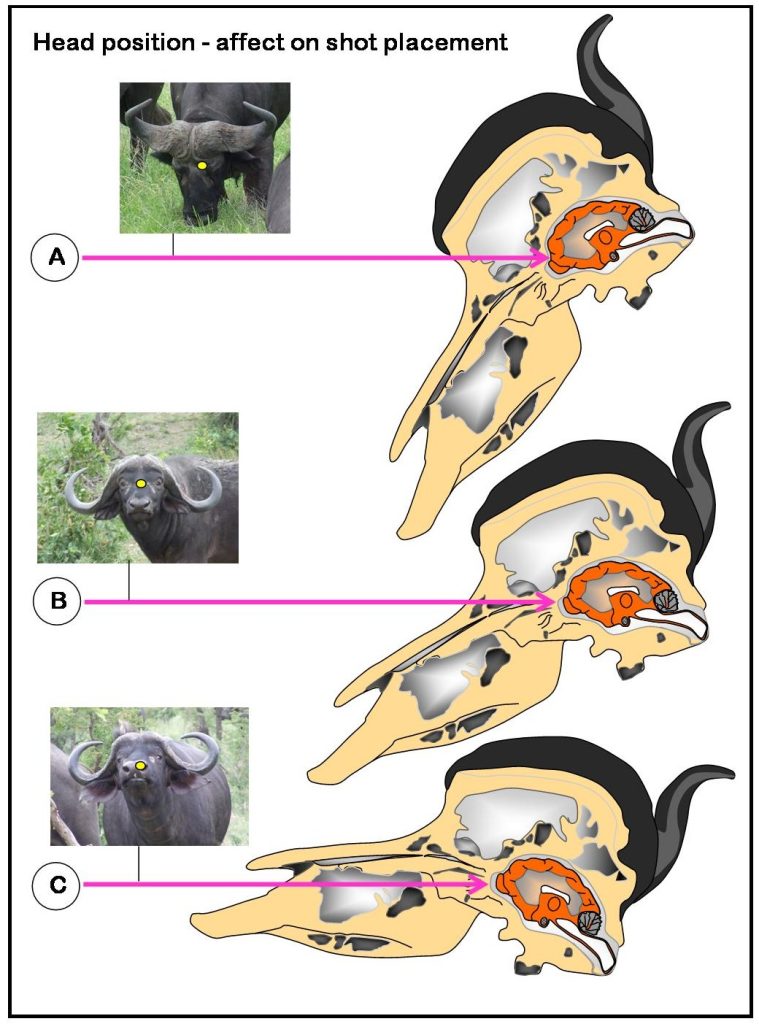
After the brain shot re-chamber another round immediately in case the buffalo you now thought dead suddenly comes to life again and an additional shot is required. Observe the animal carefully for a few minutes before finally moving in to confirm that is indeed in buffalo heaven. With a round in the chamber touch the muzzle of the rifle to the buffalo’s eyeball. If it is not yet dead it will blink and will require another shot. If the corneal reflex is absent it can now safely be assumed that the animal has expired and you can heave a sigh of relief. Please remember that there is still a round in the chamber of the rifle so make it safe before continuing with whatever comes next.
If the wounded buffalo gets away before it can be dropped with a second shot then you are faced with a different ball game. Most animals take flight headed into the wind and this should assist you in your follow-up as you should attempt if at all possible, to track the wounded buffalo with any breeze in your favour. Now opinions may differ according to personal experience but there is just too much evidence out there indicating that in some (if not all) cases a wounded buffalo will circle back on its trail to wait in ambush if it becomes aware of the fact that it is being pursued and to get downwind of the pursuer. See Figure 8.
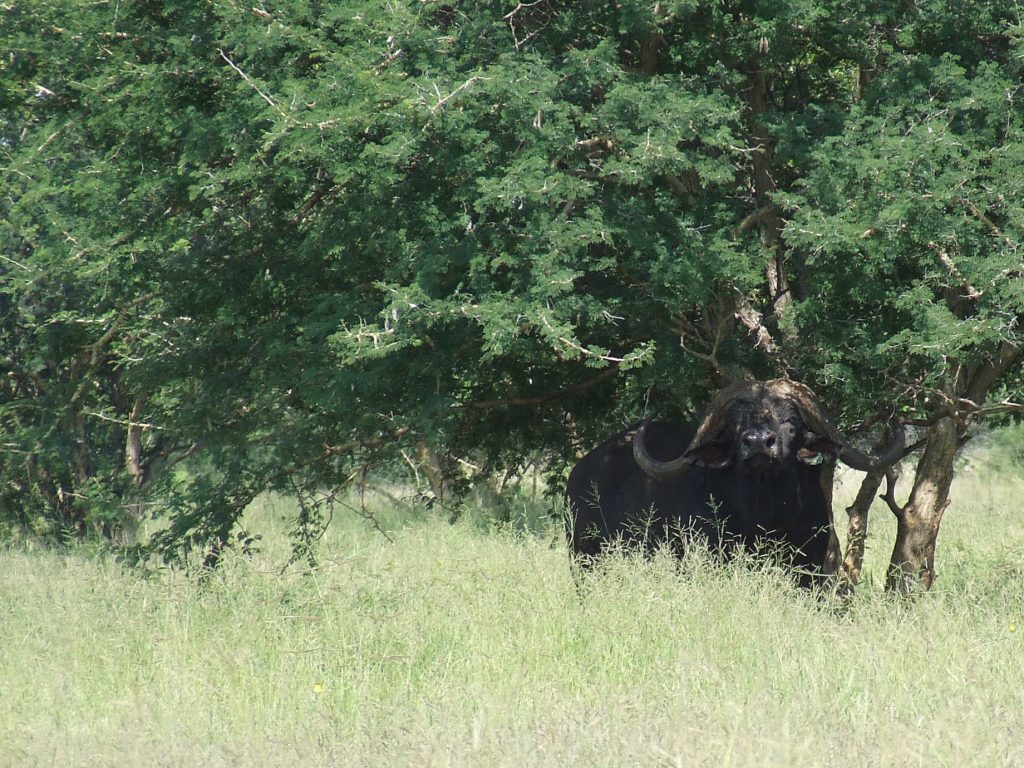
This, legend would have it, is where the buffalo thorn gets its name from. One thorn pointing straight forward and the other circling back. Either that happens or else the animal that is in pain and discomfort will eventually find a place to seek shelter or to lie up in – often a thicket or dense bush – and the hunter on its spoor will eventually “bump into it” – the end result is still the same – confrontation! See Figure 9.
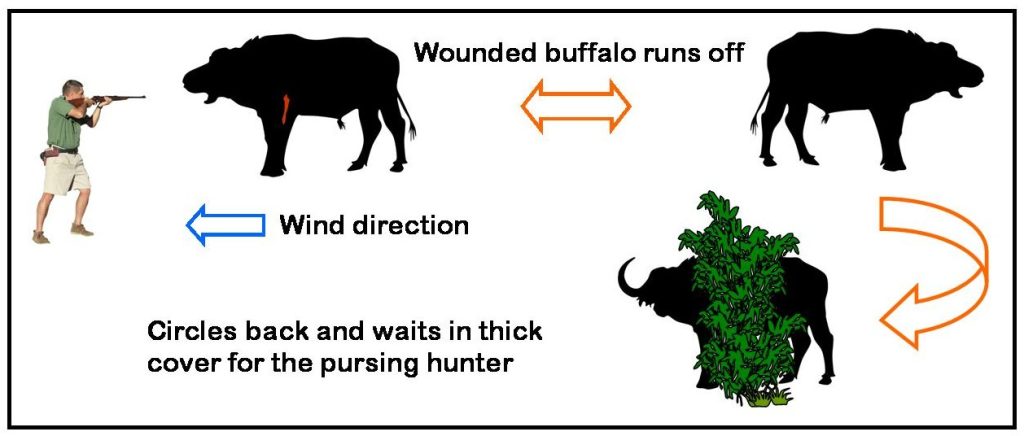
It is at this juncture that a situation can develop quite unexpectedly and with alarming speed. If the hunter passes a certain threshold without having become aware of the buffalo it will in many instances choose to charge and bring about the swift demise of its tormentor. The hunter may only have time to get a single shot in and if the shot does not drop the buffalo in its tracks our intrepid explorer is headed either for intensive care or the undertaker. By implication, there is only one shot that will work and that is one that destroys the brain.
The hunter should attempt to buy himself some time and space to manoeuvre in by carefully observing up ahead with the hope of seeing the buffalo at a reasonable distance from which it can be safely engaged rather than not spotting it in time and being suddenly faced with a head-on charge at close range.
If a brain shot has been delivered and the animal collapses go through the same procedures as outlined earlier on.
Bear in mind that even under good light conditions buffalo have the remarkable ability to hide almost unseen in the shadows of undergrowth. In failing light, it becomes even more difficult to spot the creature, and the difficulty of the follow-up is significantly compounded.
Following up a wounded buffalo is one of those contradictions in terms that are difficult to explain. When you are in the process of tracking through tangled undergrowth, being scratched by thorns, sweat stinging your eyes and not sure when that great feared beast is going to come hurtling at you with murderous intent you will be wishing you had never got yourself into the predicament to begin with but if all turns out well in the end (for you that is) it will be a day you will never forget.

